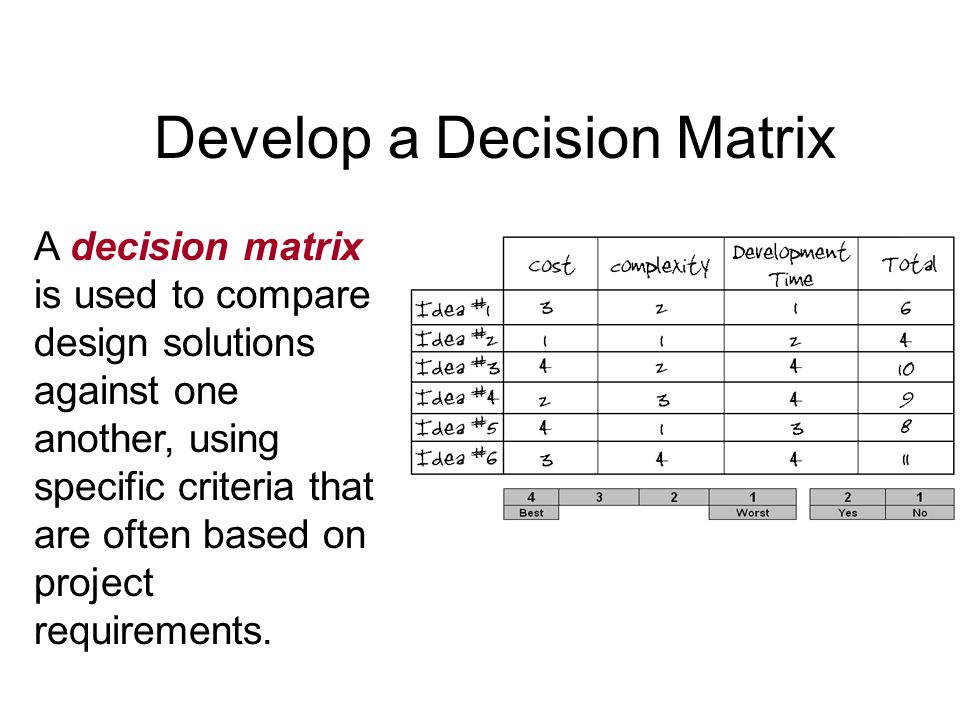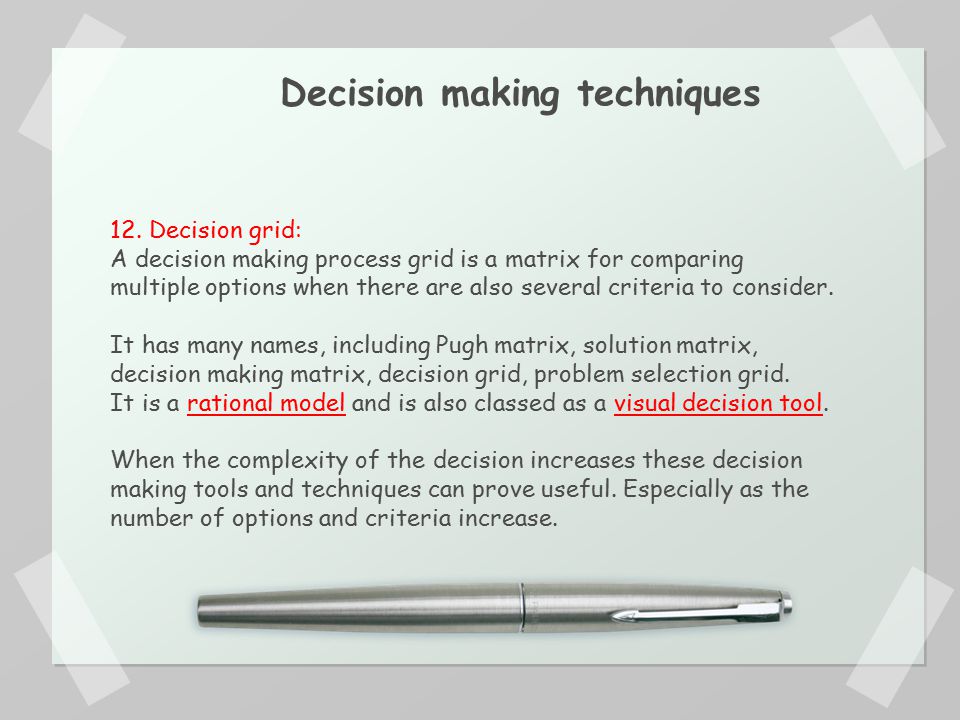Decision Making Method Matrix
- Decision Making Matrix Levels
- Decision Making Matrix Template
- Decision Making Method Matrix Calculator

Jul 20, 2018 A decision matrix helps leaders evaluate. But the tool has evolved to a general decision-making aid. Also known as the Pugh method, grid analysis or the multi-attribute utility theory, a.
A decision matrix is a list of values in rows and columns that allows an analyst to systematically identify, analyze, and rate the performance of relationships between sets of values and information. Elements of a decision matrix show decisions based on certain decision criteria. The matrix is useful for looking at large masses of decision factors and assessing each factor’s relative significance.
Description[edit]
Decision matrix is used to describe a multi-criteria decision analysis (MCDA) problem. An MCDA problem, where there are M alternative options and each need to be assessed on N criteria, can be described by the decision matrix which has N rows and M columns, or M × N elements, as shown in the following table. Each element, such as Xij, is either a single numerical value or a single grade, representing the performance of alternative i on criterion j. For example, if alternative i is 'car i', criterion j is 'engine quality' assessed by five grades {Exceptional, Good, Average, Below Average, Poor}, and 'Car i' is assessed to be 'Good' on 'engine quality', then Xij = 'Good'. These assessments may be replaced by scores, from 1 to 5. Sums of scores may then be compared and ranked, to show the winning proposal.
| Alternative 1 | Alternative 2 | .. | Alternative M | |
|---|---|---|---|---|
| Criterion 1 | x11 | x12 | .. | x1M |
| Criterion 2 | x21 | x22 | .. | x2M |
| .. | .. | .. | Xij = Good | .. |
| Criterion N | xN1 | xN2 | .. | xNM |
| Sum | ||||
| Rank | ||||
| Status | No | No |
Similar to a decision matrix, a belief decision matrix is used to describe a multiple criteria decision analysis (MCDA) problem in the Evidential Reasoning Approach. Instead of being a single numerical value or a single grade as in a decision matrix, each element in a belief decision matrix is a belief distribution.
For example, suppose Alternative i is 'Car i', Criterion j is 'Engine Quality' assessed by five grades {Excellent, Good, Average, Below Average, Poor}, and 'Car i' is assessed to be “Excellent” on 'Engine Quality' with a high degree of belief (e.g. 0.6) due to its low fuel consumption, low vibration and high responsiveness. At the same time, the quality is also assessed to be only “Good” with a lower degree of belief (e.g. 0.4 or less) because its quietness and starting can still be improved. If this is the case, then we have Xij={ (Excellent, 0.6), (Good, 0.4)}, or XijIzotope ozone 5 download. ={ (Excellent, 0.6), (Good, 0.4), (Average, 0), (Below Average, 0), (Poor, 0)}.
A conventional decision matrix is a special case of belief decision matrix when only one belief degree in a belief structure is 1 and the others are 0.

| Criterion 1 | Criterion 2 | .. | Criterion N | |
|---|---|---|---|---|
| Alternative 1 | x11 | x12 | .. | x1N |
| Alternative 2 | x21 | x22 | .. | x2N |
| .. | .. | .. | Xij={ (Excellent, 0.6), (Good, 0.4)} | .. |
| Alternative M | xM1 | xM2 | .. | xMN |
Decision Making Matrix Levels
See also[edit]
References[edit]
Decision Making Matrix Template
- Shafer, G.A. (1976). Mathematical Theory of Evidence. Princeton University Press. ISBN0-691-08175-1.
- Yang J.B., Singh M.G. (1994). 'An evidential reasoning approach for multiple attribute decision making with uncertainty'. IEEE Transactions on Systems, Man, and Cybernetics. 24: 1–18. doi:10.1109/21.259681.
- Yang J.B., Xu D.L. (2002). 'On the evidential reasoning algorithm for multiple attribute decision analysis under uncertainty'. IEEE Transactions on Systems, Man and Cybernetics Part A: Systems and Humans. 32 (3): 289–304. doi:10.1109/TSMCA.2002.802746.